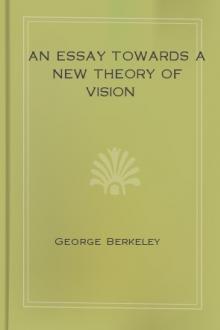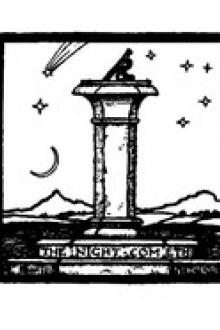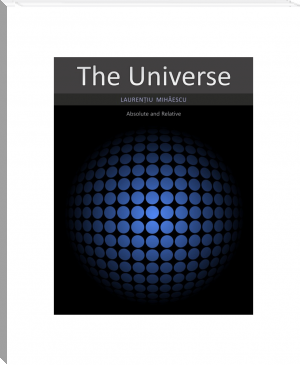An Essay Towards a New Theory of Vision, George Berkeley [best ebook reader for surface pro txt] 📗

- Author: George Berkeley
- Performer: -
Book online «An Essay Towards a New Theory of Vision, George Berkeley [best ebook reader for surface pro txt] 📗». Author George Berkeley
All which seems to arise from want of a due application of our discerning faculty, thereby to discriminate between the ideas that are in our understandings, and consider them apart from each other; which would preserve us from confounding those that are different, and make us see what ideas do, and what do not include or imply this or that other idea.
67. There is a celebrated phenomenon, the solution whereof I shall attempt to give by the principles that have been laid down, in reference to the manner wherein we apprehend by sight the magnitude of objects. The apparent magnitude of the moon when placed in the horizon is much greater than when it is in the meridian, though the angle under which the diameter of the moon is seen be not observed greater in the former case than in the latter: and the horizontal moon doth not constantly appear of the same bigness, but at some times seemeth far greater than at others.
68. Now in order to explain the reason of the moon’s appearing greater than ordinary in the horizon, it must be observed that the particles which compose our atmosphere intercept the rays of light proceeding from any object to the eye; and by how much the greater is the portion of atmosphere interjacent between the object and the eye, by so much the more are the rays intercepted; and by consequence the appearance of the object rendered more faint, every object appearing more vigorous or more faint in proportion as it sendeth more or fewer rays into the eye. Now between the eye and the moon, when situated in the horizon, there lies a far greater quantity of atmosphere than there does when the moon is in the meridian. Whence it comes to pass that the appearance of the horizontal moon is fainter, and therefore by sect. 56 it should be thought bigger in that situation than in the meridian, or in any other elevation above the horizon.
69. Farther, the air being variously impregnated, sometimes more and sometimes less, with vapours and exhalations fitted to retund and intercept the rays of light, it follows that the appearance of the horizontal moon hath not always an equal faintness, and by consequence that luminary, though in the very same situation, is at one time judged greater than at another.
70. That we have here given the true account of the phenomena of the horizontal moon will, I suppose, be farther evident to anyone from the following considerations. FIRST, it is plain that which in this case suggests the idea of greater magnitude must be something which is itself perceived; for that which is unperceived cannot suggest to our perception any other thing. SECONDLY, it must be something that does not constantly remain the same, but is subject to some change or variation, since the appearance of the horizontal moon varies, being at one time greater than at another. And yet, THIRDLY, it cannot be the visible figure or magnitude, since that remains the same, or is rather lesser, by how much the moon is nearer to the horizon. It remains therefore that the true cause is that affection or alteration of the visible appearance which proceeds from the greater paucity of rays arriving at the eye, and which I term FAINTNESS: since this answers all the forementioned conditions, and I am not conscious of any other perception that doth.
71. Add to this that in misty weather it is a common observation that the appearance of the horizontal moon is far larger than usual, which greatly conspires with and strengthens our opinion. Neither would it prove in the least irreconcilable with what we have said, if the horizontal moon should chance sometimes to seem enlarged beyond its usual extent, even in more serene weather. For we must not only have regard to the mist which happens to be in the place where we stand; we ought also to take into our thoughts the whole sum of vapours and exhalations which lie betwixt the eye and the moon: all which cooperating to render the appearance of the moon more faint, and thereby increase its magnitude, it may chance to appear greater than it usually does, even in the horizontal position, at a time when, though there be no extraordinary fog or haziness, just in the place where we stand, yet the air between the eye and the moon, taken all together, may be loaded with a greater quantity of interspersed vapours and exhalations than at other times.
72. It may be objected that in consequence of our principles the interposition of a body in some degree opaque, which may intercept a great part of the rays of light, should render the appearance of the moon in the meridian as large as when it is viewed in the horizon. To which I answer, it is not faintness anyhow applied that suggests greater magnitude, there being no necessary but only an experimental connexion between those two things. It follows that the faintness which enlarges the appearance must be applied in such sort, and with such circumstances, as have been observed to attend the vision of great magnitudes. When from a distance we behold great objects, the particles of the intermediate air and vapours, which are themselves unperceivable, do interrupt the rays of light, and thereby render the appearance less strong and vivid: now, faintness of appearance caused in this sort hath been experienced to coexist with great magnitude. But when it is caused by the interposition of an opaque sensible body, this circumstance alters the case, so that a faint appearance this way caused doth not suggest greater magnitude, because it hath not been experienced to coexist with it.
73. Faintness, as well as all other ideas or perceptions which suggest magnitude or distance, doth it in the same way that words suggest the notions to which they are annexed. Now, it is known a word pronounced with certain circumstances, or in a certain context with other words, hath not always the same import and signification that it hath when pronounced in some other circumstances or different context of words. The very same visible appearance as to faintness and all other respects, if placed on high, shall not suggest the same magnitude that it would if it were seen at an equal distance on a level with the eye. The reason whereof is that we are rarely accustomed to view objects at a great height; our concerns lie among things situated rather before than above us, and accordingly our eyes are not placed on the top of our heads, but in such a position as is most convenient for us to see distant objects standing in our way. And this situation of them being a circumstance which usually attends the vision of distant objects, we may from hence account for (what is commonly observed) an object’s appearing of different magnitude, even with respect to its horizontal extension, on the top of a steeple, for example, an hundred feet high to one standing below, from what it would if placed at an hundred feet distance on a level with his eye. For it hath been shown that the judgment we make on the magnitude of a thing depends not on the visible appearance alone, but also on divers other circumstances, any one of which being omitted or varied may suffice to make some alteration in our judgment. Hence, the circumstances of viewing a distant object in such a situation as is usual, and suits with the ordinary posture of the head and eyes being omitted, and instead thereof a different situation of the object, which requires a different posture of the head taking place, it is not to be wondered at if the magnitude be judged different: but it will be demanded why an high object should constantly appear less than an equidistant low object of the same dimensions, for so it is observed to be: it may indeed be granted that the variation of some circumstances may vary the judgment made on the magnitude of high objects, which we are less used to look at: but it does not hence appear why they should be judged less rather than greater? I answer that in case the magnitude of distant objects was suggested by the extent of their visible appearance alone, and thought proportional thereto, it is certain they would then be judged much less than now they seem to be (VIDE sect. 79). But several circumstances concurring to form the judgment we make on the magnitude of distant objects, by means of which they appear far larger than others, whose visible appearance hath an equal or even greater extension; it follows that upon the change or omission of any of those circumstances which are wont to attend the vision of distant objects, and so come to influence the judgments made on their magnitude, they shall proportionably appear less than otherwise they would. For any of those things that caused an object to be thought greater than in proportion to its visible extension being either omitted or applied without the usual circumstances, the judgment depends more entirely on the visible extension, and consequently the object must be judged less. Thus in the present case the situation of the thing seen being different from what it usually is in those objects we have occasion to view, and whose magnitude we observe, it follows that the very same object, being an hundred feet high, should seem less than if it was an hundred feet off on (or nearly on) a level with the eye.
What has been here set forth seems to me to have no small share in contributing to magnify the appearance of the horizontal moon, and deserves not to be passed over in the explication of it.
74. If we attentively consider the phenomenon before us, we shall find the not discerning between the mediate and immediate objects of sight to be the chief cause of the difficulty that occurs in the explication of it. The magnitude of the visible moon, or that which is the proper and immediate object of vision, is not greater when the moon is in the horizon than when it is in the meridian. How comes it, therefore, to seem greater in one situation than the other? What is it can put this cheat on the understanding? It has no other perception of the moon than what it gets by sight: and that which is seen is of the same extent, I say, the visible appearance hath the same, or rather a less, magnitude when the moon is viewed in the horizontal than when in the meridional position: and yet it is esteemed greater in the former than in the latter. Herein consists the difficulty, which doth vanish and admit of a most easy solution, if we consider that as the visible moon is not greater in the horizon than in the meridian, so neither is it thought to be so. It hath been already shown that in any act of vision the visible object absolutely, or in itself, is little taken notice of, the mind still carrying its view from that to some tangible ideas which have been observed to be connected with it, and by that means come to be suggested by it. So that when a thing is said to appear great or small, or whatever estimate be made of the magnitude of any thing, this is meant not of the visible but of the tangible object. This duly considered, it will be no hard matter to reconcile the seeming contradiction there is, that the moon should appear of a different bigness, the visible magnitude thereof remaining still the same.





Comments (0)